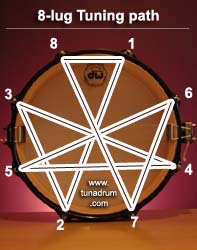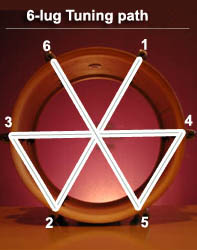Tuning a drum’s main batter head
Batter tuning is the act of accurately tuning the head to its playing pitch. See the section later in the article on tuning intervals and drum fundamentals to decide how you are going to pitch the drums individually and as a unit.
Batter tuning is similar to the process that you used to ensure even pitch across the head when seating. It is an accurate form of tuning and knowing how to tune properly is necessary when you need your drums to have their best possible sound,
this usually in the studio or some other arena where your tuning will be subject to potential microscopic examination. YMMV of course.
Using the lug pairings as previously defined for seating, use ½ turns all around the drum then ¼ turns, then smaller turns of the key until you reach your desired pitch with the tensions pretty even across the drum. Tap the drum in the centre and listen for how many tones you can hear.  You are striving to achieve one single pure note, it is most unlikely that you will hear it at this point and you will probably hear one dominant low tone (fundamental)
You are striving to achieve one single pure note, it is most unlikely that you will hear it at this point and you will probably hear one dominant low tone (fundamental)
plus a number of other tones called overtones which are caused by slightly different tensions across the head at different points.
Keep checking that you are working with the fundamental, overtones can be deceptive.
Tap at each tuning point, 1” in from the rim and listen for the overtone mix. Some points may have one single clear note, others will be a mish-mash of tones. Listen carefully for modulations in the tone called ‘beat frequencies’, you will be able to hear the waveforms interacting (beating) and this should sound like ‘wah-wah’ oscillations or moving variations in the pitch.
Compare the pitch at this lug to the overall fundamental or to the pure-toned lugs and using very small increments either loosen or tighten the lug.
As you loosen or tighten, tap the tuning point on the head and listen to how the ‘beating’ of the waveforms changes, if they get faster / closer together then you are going the wrong way, if they slow down or ‘flatten out’ then you are going the correct way. Be sure to change each lug of the pair by equal amounts. You
may find that the waves get flatter and then start to become more active again, this is because you have one or more further pairs out of tune, just ensure that each pair has the flattest possible waveform and continue working around the drum. This takes practise and the development of your ‘ear’, the more you do this, the better you will hear the beat frequencies and the better you will be able to tune the drum.
Depending on how even you have the base tuning of the drum,
it may take you to work at several of the lugs to get a single pure wave, the best teacher is experience and you will likely need to tweak the original pure-toned lugs as they will have changed because of your working with the surrounding tensions.
You know that the drum is in tune when no matter where you hit the head you get one single solid resonant note that sustains.
Ok so now you have tuned the batter head on your drum, next on the agenda is to repeat the process on the resonant head.


